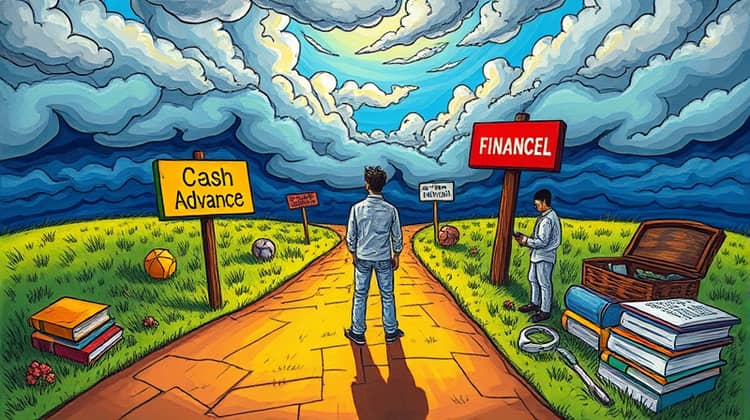In today’s fast-paced world, financial emergencies can arise at any moment. When unexpected expenses crop up, many consumers turn to their credit cards for quick cash solutions. One such option is a credit card cash advance, but is it the right choice for you? This article will explore the ins and outs of cash advances, helping you determine if they align with your financial needs.
Credit card cash advances allow you to withdraw cash directly from your credit card account, offering a convenient way to access funds. However, convenience often comes at a high cost, and understanding all aspects of cash advances empowers you to make informed financial decisions.
This guide will cover various dimensions of credit card cash advances, including their workings, costs, potential risks, and alternatives. By the end, you’ll have a clearer understanding of whether a cash advance is suitable for your circumstances and how it fits into your larger financial strategy.
What is a Credit Card Cash Advance?

A credit card cash advance is a service provided by credit card issuers, allowing cardholders to withdraw cash, often through ATMs, or directly from the bank. It’s akin to a personal loan in a sense, where you are taking a short-term loan against your available credit limit with the expectation of paying it back later, typically with interest and fees.
Unlike regular credit card purchases that come with a grace period where interest may not accrue if paid in full, cash advances start accumulating interest immediately. This difference is vital for anyone considering a cash advance, as it can lead to much higher financial obligations than anticipated.
Furthermore, cash advances come with their own limits—often lower than your overall credit limit—which can change based on the policies of your credit card provider. This can make it a useful resource in a pinch, but it’s crucial to use this option judiciously.
How Does it Work?

Using a credit card for a cash advance is relatively straightforward. Cardholders can simply go to an ATM that accepts their card or visit a bank branch. After inserting their credit card, they will follow the prompts to withdraw cash, entering the desired amount and their PIN to complete the transaction. Cash can also be obtained through checks issued by the credit card provider, endorsing the check and cashing it at a bank.
Once the transaction is completed, the cash advance amount is subtracted from the available credit limit, and the cardholder is responsible for repaying this amount, along with any interest or fees that may apply. It’s worth noting that fees vary by issuer and can include ATM fees as well as a percentage of the cash withdrawn. In some cases, promotional cash advance rates may be offered temporarily, but these are rare.
- Visit an ATM or bank that accepts your credit card.
- Insert your card and follow the prompts to withdraw cash.
- Enter the desired amount and your PIN to complete the transaction.
Why People Seek Cash Advances

Individuals often seek cash advances for various reasons, primarily born out of necessity. Given their accessibility, cash advances provide funds quickly for emergency expenses such as medical bills, car repairs, or urgent travel needs. Their immediacy compared to traditional loans appeals to cardholders who need swift financial relief.
- To cover urgent expenses
- To deal with unexpected bills
- For convenience in a financial emergency
The High Costs Involved

While the option of a cash advance offers immediate relief, it’s important to consider the associated costs. Interest rates on cash advances are often significantly higher than those of regular credit card purchases, and there is no grace period. This means that if you cannot pay back the amount quickly, the debt can grow rapidly.
Additionally, many credit cards impose a cash advance fee which can range from a flat fee to a percentage of the total withdrawal, further increasing the cost of accessing cash in this method. It's crucial to keep these expenses in mind when evaluating whether a cash advance is appropriate for your situation.
- High-interest rates applied immediately
- Cash advance fees charged by the issuer
- Lower credit limit available for purchases
- No grace period for repayment
These high costs can quickly add up and lead to a cycle of debt that’s hard to manage, making a cash advance a risky financial move for some individuals. It's advisable to calculate total costs before deciding to utilize this option so that you can weigh it against other alternatives that may be less costly.
If you find yourself needing to rely on cash advances frequently, it may be worth considering a longer-term solution to manage your finances. Constantly using cash advances could indicate underlying financial issues that may benefit from professional advice or tailored budgeting strategies.
Potential Risks

Utilizing a credit card cash advance isn't without its risks. First and foremost, the high-interest rates can lead to spiraling debt if the amount isn't repaid swiftly. It can be all too easy to fall into a cycle where you're continually relying on cash advances to pay off previous ones, making it harder to break free from this financial strain.
Additionally, frequent cash advances can negatively impact your credit score. Credit utilization rates play a significant role in determining your credit score, and using a large portion of your available credit for cash advances can signal to credit bureaus that you’re financially distressed, which can lower your score over time.
- High interest rates can lead to debt accumulation
- Potential to negatively affect credit score
- Risk of ongoing cycle of borrowing
Alternative Options to Consider

If you find yourself considering a cash advance, it’s wise to explore alternative options. Often, there are safer and more cost-effective ways to tackle unexpected financial needs without delving into high-interest cash advances.
- Personal loans from banks or credit unions
- Borrowing from friends or family
- Low-interest credit cards with promotional offers
- Payday alternative loans that offer lower rates
Conclusion

In conclusion, while credit card cash advances offer quick access to cash during emergencies, they come with significant costs and risks that can lead to financial stress. It’s crucial to weigh these factors carefully and consider your options before opting for a cash advance.
Ultimately, developing a comprehensive understanding of your financial situation and exploring alternative resources can help you make better decisions, ensuring that you’re equipped to handle emergencies without falling into debt traps. Financial literacy empowers consumers to navigate their choices wisely and choose what works best for their unique situations.














